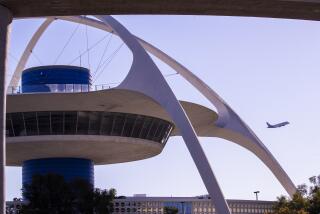Midway Tailwind Had Some Worried
- Share via
CHICAGO — Radio communications recorded before last week’s fatal accident at Midway International Airport reveal that some pilots and air-traffic controllers had discussed whether they could change the runway configuration to escape a tailwind that increased the stopping distance of planes landing in the worsening snowstorm, the Tribune has learned.
But the only possible runway switch at Midway would have caused an air-traffic jam, curtailing the use of a major departure runway at O’Hare International Airport about 20 miles away, officials said.
Swapping runway operations also would have added to the serious weather-related flight delays at both airports.
Only one Midway runway was open Thursday night when a Southwest Airlines plane skidded across the airfield and smashed through a jet-engine blast barrier and a perimeter fence, striking cars on a busy street. Joshua Woods, a 6-year-old who was in one of the cars, was killed; 10 other people were injured.
Midway flights were restricted to the one runway because city crews could not de-ice and plow other runways fast enough to keep up with the falling and blowing snow.
Planes regularly approach fast and low over homes in the airport’s surrounding neighborhoods, landing on relatively short runways.
The National Transportation Safety Board is investigating why the Federal Aviation Administration, the Chicago Department of Aviation and the airlines serving Midway did not implement a safer runway plan to put a headwind against the noses of landing planes, investigators said.
“Our air-traffic group is looking at the decision-making process and how they decided which runway to use and which ones not to use,” safety board spokesman Keith Holloway said Sunday. “We are also examining the responses between the pilots and the air-traffic controllers and what they viewed as the conditions of the runway.”
The general rule to land and take off into the wind is one of the first lessons a pilot receives, and many airlines mandate it in strong winds or other adverse conditions.
A plane moves more slowly when landing against the wind, decreasing the distance it needs to stop.
“I find it hard to believe that any airline pilot would knowingly land in such a tailwind under any conditions, and most certainly not at Midway on a slippery runway,” said retired Capt. Tom Bunn, who flew for United and Pan Am airlines for 30 years.
Air-traffic radio tapes show that several pilots Thursday night asked whether there was a way to land into a headwind instead of the 10 mph tailwind that hit planes at an angle, sources close to the National Transportation Safety Board investigation said.
Investigators will look at whether visibility rules set by the FAA for Midway permitted the use of a different landing configuration.
The pilots of the Southwest plane, Flight 1248 from Baltimore, reported a normal approach to Midway and did not request a change in runway, said Robert Benzon, who is heading the safety board’s investigation.
Other aircraft landed safely at Midway before Flight 1248 skidded and crashed. The safety board is expected to take at least a year to investigate issues including the weather, runway snow removal, aircraft performance, mechanical systems and human factors.
More to Read
Sign up for Essential California
The most important California stories and recommendations in your inbox every morning.
You may occasionally receive promotional content from the Los Angeles Times.













